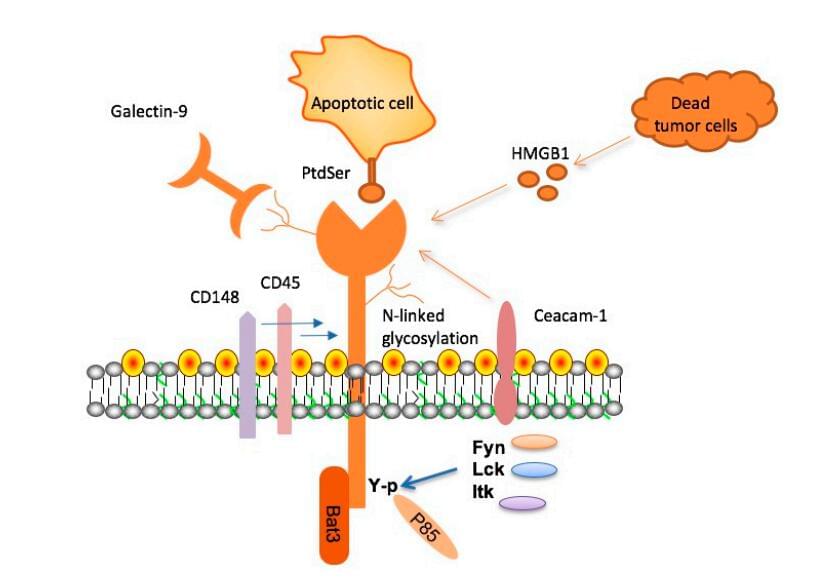Hi-Affi™ Humanized TIM3 Immune Checkpoint Knockin Mouse Model
The cancer immunotherapy has scored tremendous achievements in the past few years driven by the discovery of immune checkpoint targets, e.g. PD-1, PD-L1, CTLA-4, CD47, etc. Striking preclinical/clinical success has been achieved in the development of anti-immune checkpoint antibodies. Closely following the world trend, Creative Biolabs is proud to introduce our full range of Hi-Affi™ humanized immune checkpoint mice that are specially designed for in vivo evaluation of immunotherapy antibodies. Currently, we provide this innovative humanized TIM-3 immune checkpoint knock-in mice to our global clients.
TIM-3 Immune Checkpoint Receptor
T-cell inhibitory receptor TIM-3 (T-cell immunoglobulin and mucin domain 3) is expressed on Th1, Th17, CD8+ T cells and it is a T cell inhibitory receptor. TIM family is a kind of membrane protein, which contains three parts: a variable immunoglobulin domain (IgV), a glycosylated mucin domain of varying length in the extracellular region, and a single transmembrane domain. TIM-3 has four relevant ligands, which include galectin-9 (Gal-9), high mobility group protein B1 (HMGB1), carcinoembryonic antigen cell adhesion molecule 1 (Ceacam-1), and phosphatidylserine (PtdSer). Gal-9 can bind to TIM-3 and incite an influx of calcium to the intracellular region of Th1 cells, inducing T cell apoptosis. The interaction of PtdSer and TIM3 facilitates the clearance of apoptotic bodies and also promotes the cross-presentation of antigens by dendritic cells (DCs). HMGB1 is the key ligand that activates of normal dendritic cells (DCs) and that TIM-3 inhibit the role of HMGB1 in tumor-infiltrating DCs. The interaction between Ceacam-1 and TIM-3 is functioned as a negative regulator of T cell responses.
 Fig.1 T cell immunoglobulin and mucin domain 3 (TIM-3), its ligands, and signaling adaptor proteins (Du et al. 2017) 1,2
Fig.1 T cell immunoglobulin and mucin domain 3 (TIM-3), its ligands, and signaling adaptor proteins (Du et al. 2017) 1,2
TIM-3 for Immunotherapy of Cancer
TIM-3 is induced in Th1 cells and inhibits Th1-mediated immune responses by directly triggering apoptosis. Tim-3 is an intriguing candidate for the next wave of therapies due to its demonstrated success in multiple preclinical cancer models. The use of TIM-3 mAbs showed antitumor effects in many mouse tumor models, and the combination of TIM-3 mAbs and CTLA4 mAbs has had much greater antitumor effects.
Development of Humanized TIM-3 Immune Checkpoint Knock-In Mice
TIM-3 has been shown to be upregulated in tumor infiltrating lymphocytes in mouse tumor models. However, immunodeficient mice are not adequate to test immunotherapy as they lack a human immune system. Mice with human functional hematopoietic cells or human knock-in (KI) genes represent a much more attractive choice to test drugs targeting human immune cells. Given this, Creative Biolabs has developed a Hi-Affi™ platform to provide a serial of well-established humanized immune checkpoint KI mouse models. Particularly, we provide TIM-3 KI mouse model, to test diverse anti-TIM-3 agents.
Meanwhile, we can also provide a broad range of immune checkpoint mouse models, including but not limited to:
Currently, we also provide a full range of other Humanized Mouse Models to support your projects:

Our diligent scientists are always ready to deliver professional services 24/7. Please feel free to contact us for more details.
References
- Du W, Yang M, Turner A, et al. (2017) "TIM-3 as a Target for Cancer Immunotherapy and Mechanisms of Action." Int J Mol Sci 18(3).
- under Open Access license CC BY 4.0, without modification.
For Research Use Only.
